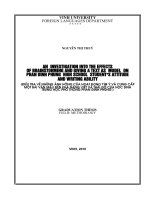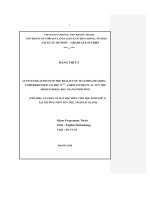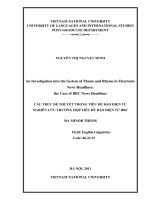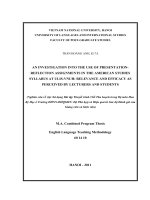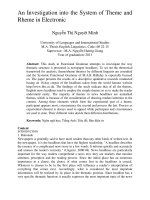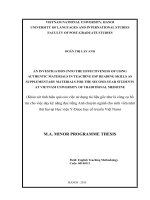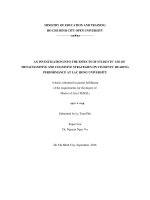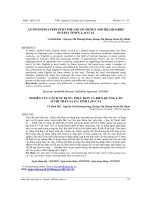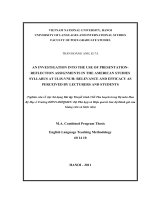An investigation into teachers promotion of student centered learning in efl speaking classes at ethnic minority boarding high schools
Bạn đang xem bản rút gọn của tài liệu. Xem và tải ngay bản đầy đủ của tài liệu tại đây (710.01 KB, 87 trang )
MINISTRY OF EDUCATION AND TRAINING
QUY NHON UNIVERSITY
HUYNH THI TUYET SUONG
AN INVESTIGATION INTO TEACHERS’ PROMOTION OF
STUDENT-CENTERED LEARNING IN EFL SPEAKING CLASSES
AT ETHNIC MINORITY BOARDING HIGH SCHOOLS
Field: Theory and Methodology of English Language Teaching
Code: 8140111
Supervisor: Dr. TRUONG VAN DINH
BỘ GIÁO DỤC VÀ ĐÀO TẠO
TRƯỜNG ĐẠI HỌC QUY NHƠN
HUỲNH THỊ TUYẾT SƯƠNG
NGHIÊN CỨU VIỆC GIÁO VIÊN THÚC ĐẨY VIỆC HỌC LẤY
HỌC SINH LÀM TRUNG TÂM TRONG CÁC TIẾT HỌC NÓI
TIẾNG ANH TẠI CÁC TRƯỜNG DÂN TỘC NỘI TRÚ
Ngành: Lí luận và phương pháp dạy học bộ môn tiếng Anh
Mã số: 8140111
Người hướng dẫn: TS. TRƯƠNG VĂN ĐỊNH
i
STATEMENT OF AUTHORSHIP
I confirm that the work presented in this research report has been
conducted by myself. Except where reference is made in the text of the
thesis, no other person’s work has been used without due
acknowledgement in the thesis. I confirm that this work is submitted in
partial fulfillment for the M.A. thesis in English at Quy Nhon University
and has not been submitted elsewhere in any other form for the
fulfillment of any other degree or qualification.
Binh Dinh, October 2023
Huỳnh Thị Tuyết Sương
ii
ACKNOWLEDGEMENTS
I wish to convey my heartfelt gratitude to all those whose
unwavering support and contributions have played an indispensable role
in bringing this research to fruition.
First and foremost, my deepest appreciation goes out to the
dedicated teachers who willingly participated in this study. Their
invaluable insights, wholehearted cooperation, and unwavering
commitment to the advancement of English language education within
ethnic minority boarding high schools have been pivotal to the success of
this research.
I am profoundly indebted to my academic advisor, Dr. Truong
Van Dinh, whose guidance, sagacity, and steadfast support have been
instrumental throughout this academic voyage. Dr. Truong Van Dinh's
expertise and mentorship have been a cornerstone of this thesis, and I am
deeply grateful for the unwavering support and guidance provided.
Acknowledgment is also due to the esteemed staff and
administrators of the ethnic minority boarding high schools in Gia Lai
province, Vietnam, for their gracious permission and provision of
indispensable resources, which have been instrumental in the completion
of this research.
Last but certainly not least, I wish to express my appreciation to
the broader academic community and the numerous scholars whose prior
research and publications have formed the bedrock upon which this
study is constructed.
This research endeavor would have remained but a dream without
the invaluable contributions and support of these exceptional individuals
and institutions. I offer my heartfelt thanks to all who have been an
integral part of this remarkable journey.
iii
ABSTRACT
This thesis explores the application and perceptions of student-
centered learning (SCL) within the framework of English as a Foreign
Language (EFL) speaking courses offered at boarding high schools
serving ethnic minority populations in Gia Lai province, Vietnam. The
central objective of this research endeavor is to gain a comprehensive
understanding of how EFL instructors conceptualize, implement, and are
impacted by SCL in their pedagogical practices.
The research methodology employed a mixed-methods approach,
encompassing the administration of questionnaires, classroom
observations, and interviews, in order to amass data from a cohort of
eight EFL educators functioning within the designated educational
institutions. The outcomes of the study have disclosed that the majority
of instructors operating in this context actively endorse the principles of
SCL. These principles revolve around nurturing learner autonomy,
fostering active participation, encouraging collaborative learning, and
accommodating flexibility within the instructional setting. Nonetheless,
the research has also identified several formidable impediments to the
complete integration of SCL, including challenges related to the varying
proficiency levels among students, inadequacy of classroom resources,
and the constraints imposed by the prevailing curriculum requirements.
The findings underscore the limited institutional support and
resources available to instructors as they endeavor to adopt SCL
techniques, thereby underscoring the pressing necessity for
comprehensive professional development opportunities and curricular
guidance. Moreover, this study underlines the critical importance of
recognizing and addressing the distinctive challenges that instructors
face in classrooms characterized by ethnic diversity.
In summary, this research endeavor furnishes valuable
contributions to the field of EFL pedagogy in the particular context of
ethnic minority boarding high schools in Vietnam. It also offers
profound insights into the multifaceted nature of SCL implementation.
Ultimately, the study advocates for customized support mechanisms and
resource provision to aid instructors in surmounting obstacles and
establishing more inclusive and efficacious learning environments.
iv
TABLE OF CONTENTS
STATEMENT OF AUTHORSHIP ........................................................ i
ACKNOWLEDGEMENTS.................................................................... ii
TABLE OF CONTENTS....................................................................... iv
LIST OF ABBREVIATIONS .............................................................. vii
LIST OF TABLES ...............................................................................viii
CHAPTER 1: INTRODUCTION.......................................................... 1
1.1. Rationale ........................................................................................ 1
1.2. Aim and Objectives of the Study ................................................. 3
1.2.1. Aim of the Study....................................................................... 3
1.2.2. Objectives of the Study............................................................. 3
1.3. Research Questions ....................................................................... 4
1.4. Scope of the Study ......................................................................... 4
1.4.1. Geographical Scope ................................................................. 5
1.4.2. Educational Level .................................................................... 5
1.4.4. Participants............................................................................... 5
1.4.5. Time Frame .............................................................................. 5
1.5. Significance of the Study .............................................................. 5
1. 6. Organization of the Study ........................................................... 7
CHAPTER 2: THEORETICAL BACKGROUND AND
LITERATURE REVIEW....................................................................... 9
2.1. Conceptual Framework................................................................ 9
2.2. EFL Teachers' Role in Promoting Student-Centered
Learning .............................................................................................. 11
2.3. Speaking Skills............................................................................. 12
2.3.1. Definition................................................................................ 12
2.3.2. Importance of Speaking......................................................... 13
2.3.3. Classroom Speaking Activities .............................................. 13
v
2.3.4. Assessment of Speaking Skills............................................... 14
2.4. Ethnic Minority Boarding High Schools in Vietnam .............. 16
2.5. Previous Research Related to the Study ................................... 16
2.6. Summary...................................................................................... 19
CHAPTER 3: RESEARCH METHODOLOGY ............................... 20
3.1. Research Methods ....................................................................... 20
3.3. Data Collection Instrument........................................................ 24
3.3.1. Questionnaire ......................................................................... 24
3.3.2. Observation............................................................................. 26
3.3.3. Interview ................................................................................. 27
4.1. Questionnaire Analysis ............................................................... 30
4.1.1. Section One: Demographic Information (Questions 1-4).... 30
4.1.3. Section 3: Student-Centered Approaches (Questions 7-9)... 33
4.1.4. Section 4: Factors Influencing Instruction (Questions 10-12)38
4.2. Observation Analysis .................................................................. 43
4.2.1. Section One: Preparation and Planning .............................. 43
4.2.2. Section 2: Teacher’s activities ............................................... 44
4.2.3. Section 3: Students’ activities ................................................ 45
4.2.4 Section 4: Assessment ............................................................. 48
4.3. Interview Analysis....................................................................... 49
4.3.1. Interpretations of Student-centered Learning ...................... 49
4.3.2. Key Principles and Characteristics of Student-centered
Learning ........................................................................................... 50
4.3.3. Strategies for Promoting Student-centered Learning .......... 51
4.3.4. Challenges in Implementing Student-centered Learning.... 52
4.3.5. Institutional Support and Professional Development .......... 53
4.4. Discussion..................................................................................... 54
4.4.1. Discussion of Questionnaire Findings ................................. 54
Section 1: Demographic Information. ............................................ 54
4.4.2. Discussion of Observation Findings ..................................... 56
vi
4.4.3. Discussion of Interview Findings.......................................... 58
CHAPTER 5: CONCLUSIONS AND IMPLICATIONS ................. 61
5.1. Conclusions .................................................................................. 61
5.1.1. Perceptions of Student-centered Learning ........................... 61
5.1.2. Implementation of Student-centered Approaches ................ 61
5.1.3. Benefits of Student-centered Learning ................................. 61
5.1.4. Factors Influencing Instruction............................................ 62
5.1.5. Support and Resources .......................................................... 62
5.1.6. Challenges in Implementation .............................................. 62
5.2. Limitations ................................................................................... 62
5.3. Suggestions for Further Studies ................................................ 64
REFERENCES
APPENDICES
vii
LIST OF ABBREVIATIONS
EFL English as a foreign language
SCL Student-centered Learning
% Percentage
EMBHS ethnic minority boarding high schools
viii
LIST OF TABLES
Table 3.1. Teachers’ Demographic Information ..................................... 22
Table 4.1. Teachers’ Gender Distribution............................................... 30
Table 4.2. Teachers’ Age Distribution.................................................... 31
Table 4.3. Teachers’ Educational Qualification ..................................... 31
Table 4.4. Teaching Experience.............................................................. 32
Table 4.5. Frequency of teaching EFL speaking classes ........................ 32
Table 4.6. Key Principles or Characteristics of Student-centered Learning.34
Table 4.7. Student-Centered Activities Used.......................................... 35
Table 4.8. Benefits of Student-Centered Learning ................................. 36
Table 4.9. Factors Influencing Decision ................................................. 38
Table 4.10. Support/Resources for Student-Centered Learning
Challenges ........................................................................... 40
Table 4.11. Challenges in Implementing Student-centered Approaches in
EFL Speaking Classes ......................................................... 42
1
CHAPTER 1: INTRODUCTION
This chapter introduces the study and is divided into five main sections:
the rationale, the aims, the objectives, the research questions, the scope, the
significance, and the structure of the study.
1.1. Rationale
In the landscape of modern education, student-centered learning has
gained significant recognition as an effective pedagogical approach that
empowers students to assume responsibility for their learning and actively
participate in the educational process (Corley, 2010). In the sphere of English
as a Foreign Language (EFL) education in Vietnam, conventional teaching
methods have predominantly prevailed, emphasizing rote memorization and
teacher-centered instruction. Nonetheless, with the escalating global demand
for proficient English communication skills, a shift towards student-centered
approaches has become imperative. This shift entails reorienting the focus
from teaching to learning and creating learning opportunities wherein the
learner evolves from a passive recipient of knowledge into an "active
participant in learning and co-constructor of knowledge" (Meece, 2003, p.
111). The role of the instructor has transformed from being a primary source
of knowledge to becoming a facilitator who designs and oversees suitable
opportunities and contexts. In such settings, students assume responsibility
for achieving self-defined group objectives. This transformation necessitates a
departure from content-intensive curricula towards curricula centered around
learners. Content-intensive curricula often constrain the development of vital
skills such as critical thinking, decision-making, problem-solving, and self-
and peer-assessment (Diekelman, 2002; Ironside, 2004; Tanner, 2004). These
competencies can be more effectively cultivated through student-centered
teaching approaches, applicable across all levels of education, including
higher education.
2
The implementation of student-centered learning is particularly salient in
the context of English as a Foreign Language instruction. In Vietnam, the
teaching and learning of English have been underscored by the National
Foreign Language 2020 Project, which emphasizes confident and proficient
use of English by most Vietnamese students. The project calls for innovative
approaches that transcend traditional teaching methods, urging educators to
actively engage students in the learning process.
The English Subject Curriculum (issued along with Circular No.
32/2018/TT-BGDĐT dated December 26, 2018 by the Minister of Education
and Training) stipulates that English is a compulsory subject in the general
education curriculum from grade 3 to grade 12. As one of the foundational
subjects in the curriculum, English serves not only to help students develop
their English communication skills but also contributes to the cultivation and
enhancement of broader competencies. These competencies are essential for
more effective living and working, excelling in other subjects, and engaging
in lifelong learning. The English language curriculum in general education
ensures that students' learning activities assume a central role in the teaching
process. Students' English communication skills are nurtured through active,
self-directed, and creative learning activities. Teachers serve as organizers
and guides in the teaching process, encouraging students' active participation
in language practice activities to the fullest extent, gradually enhancing their
self-learning capabilities.
Ethnic minority boarding high schools (EMBHS) in Gia Lai province
represent a distinctive educational context. These institutions cater to students
from diverse ethnic backgrounds, each characterized by distinct linguistic and
cultural traits. The integration of student-centered learning in EFL speaking
classes at these schools presents additional complexities, necessitating
educators to address the specific needs of these learners. While the
3
advantages of student-centered learning are well-recognized, its successful
implementation within the specialized domain of EFL speaking classes in
ethnic minority boarding high schools remains underexplored. This study
aims to bridge this gap by delving into the perceptions, practices, challenges,
and factors influencing teachers' efforts to promote student-centered learning.
Consequently, an investigation into how teachers navigate these intricacies to
foster student-centered learning is imperative for advancing educational
practices in these schools.
1.2. Aim and Objectives of the Study
1.2.1. Aim of the Study
The primary aim of the research is to comprehensively investigate and
understand how EFL teachers promote student-centered learning within the
context of English as a Foreign Language speaking classes at ethnic minority
boarding high schools in Gia Lai province, Vietnam. This is carried out by
delving into teachers' perceptions, strategies, challenges, and influencing factors
to provide valuable insights that contribute to enhancing the implementation of
student-centered pedagogies in this specific educational setting and offer a
nuanced understanding of the intricate interplay between student-centered
learning principles and the diverse needs of ethnic minority students.
Ultimately, the study aspires to bridge the gap between theoretical
principles of student-centered learning and their practical application in EFL
speaking classes at ethnic minority boarding high schools. Through its
findings, the study seeks to provide actionable recommendations for
educators, policymakers, and educational institutions, thereby contributing to
the advancement of student-centered pedagogy in the pursuit of improved
learning outcomes and holistic development for ethnic minority students.
1.2.2. Objectives of the Study
The research is underpinned by precise objectives that provide guidance
4
for the investigation into the facilitation of student-centered learning by
teachers within EFL speaking classes at Ethnic Minority Boarding High
Schools (EMBHS) in Gia Lai province. These specific objectives serve as
focal points, systematically directing the inquiry to address the research
questions and attain a comprehensive grasp of the phenomenon at hand.
This study is oriented towards the following specific objectives:
- To scrutinize the perspectives of EFL teachers regarding the concept of
student-centered learning.
- To delve into the instructional practices employed by EFL teachers in
the promotion of student-centered learning within EFL speaking classes at
EMBHS in Gia Lai province, Vietnam.
- To pinpoint and analyze the factors that exert an influence on EFL
teachers' efforts to promote student-centered learning in EFL speaking classes
at EMBHS in Gia Lai province.
1.3. Research Questions
Based on the aims and the objectives of the study, the following research
questions are poised to guide the study:
1. How do EFL teachers at EMBHS in Gia Lai province perceive the
concept of student-centered learning in EFL speaking classes?
2. What are the practices adopted by EFL teachers to promote student-
centered learning in EFL speaking classes at EMBHS in Gia Lai province?
3. What factors influence EFL teachers' promotion of student-centered
learning in EFL speaking classes at EMBHS in Gia Lai province?
1.4. Scope of the Study
The study is delimited within specific parameters to ensure a focused
and manageable investigation. The scope outlining the boundaries of the
research and clarifying the context in which the study is conducted,
encompasses the following aspects:
5
1.4.1. Geographical Scope
The study is conducted exclusively within two ethnic minority boarding
high schools in Gia Lai province.
1.4.2. Educational Level
The study focuses on high school education, specifically within the
tenth-grade English syllabus of EMBHS. Choosing the tenth grade serves as a
strategic starting point for assessing the early impact of student-centered
learning on students' language proficiency. This marks the first
implementation of Tieng Anh 10-Bright.
1.4.3. Subject Area
The study is primarily concerned with the teaching and learning of
English as a Foreign Language (EFL), particularly in the context of EFL
speaking classes.
1.4.4. Participants
The study involves EFL teachers who are actively engaged in teaching
EFL at ethnic minority boarding high schools in Gia Lai province. The study
focuses on EFL teachers’ perspectives and practices they adopt to promote
student-centered learning in EFL speaking classes.
1.4.5. Time Frame
The research is conducted in the second term of the academic year
2022/2023. The data collection and the data analysis are confined to this
specific period to maintain research feasibility.
1.5. Significance of the Study
Significantly, the study contributes to the ongoing discourse on student-
centered learning within the realm of English as a Foreign Language
education. By investigating how teachers promote student-centered learning
in the specific context of ethnic minority boarding high schools, the study
adds depth to the theoretical understanding of effective pedagogical
6
approaches. It provides insights into the alignment between student-centered
principles and the nuances of cultural and linguistic diversity, enriching the
theoretical framework that underpins modern education methodologies.
Practically, the findings of the study offer practical implications for
educators engaged in EFL teaching at ethnic minority boarding high schools.
By uncovering the strategies and practices employed by teachers to promote
student-centered learning, the research equips educators with concrete
examples of how to create engaging and effective classroom environments.
Educators can adapt these insights to their own teaching contexts, enhancing
student engagement, communication skills, and overall learning experiences.
Secondly, the study's practical implications extend to curriculum
designers and educational authorities. The research's exploration of strategies
that resonate with ethnic minority students' cultural and linguistic
backgrounds provides guidance for the development of culturally responsive
teaching materials and methods. This ensures that educational resources are
tailored to the specific needs and characteristics of the student population.
Thirdly, educational institutions and organizations responsible for
teacher training and professional development can benefit from the study's
insights. By understanding the challenges faced by EFL teachers in
implementing student-centered learning, these entities can design targeted
training programs that address specific needs and enhance educators'
capabilities in fostering student-centered environments.
Ultimately, the practical significance of the study lies in its potential to
improve learning outcomes for students. Through the effective implementation
of student-centered approaches, students are empowered to take ownership of
their learning, developing critical thinking, collaboration, and problem-solving
skills. The research's practical insights aim to foster lifelong learners who are
equipped for success in both academic and real-world contexts.
7
In summary, the study's significance is two-fold: it contributes to
theoretical discussions surrounding student-centered learning in EFL
education, while also offering practical implications that can positively
impact educators, curriculum designers, teacher trainers, and most
importantly, the learning experiences and outcomes of students in ethnic
minority boarding high schools.
1. 6. Organization of the Study
The thesis has been meticulously structured to facilitate a coherent and
comprehensive exploration of the research topic. Each chapter has been
strategically designed to build upon the preceding one, ensuring a smooth and
logical progression through the research process, methodology, findings, and
implications. The organizational framework of this study is presented as
follows:
Chapter 1, Introduction, serves as the gateway to the dissertation and
offers an overview of the research's background, objectives, research
questions, significance, scope, and organization. It sets the stage for the
subsequent chapters and provides readers with essential context.
Chapter 2, Literature Review, delves into the extensive body of relevant
literature on various aspects related to our research, including student-
centered learning, EFL teaching methods, the pivotal role of teachers in
promoting student-centered learning, the educational experiences of ethnic
minority students, and a review of previous studies conducted in similar
contexts.
Chapter 3, Research Methodology, is dedicated to a comprehensive
description of the research methodology employed in this study. It offers
insight into the research method, research setting, and data collection
instrument, that guided our research process.
Chapter 4, Findings and Discussion, built upon the foundation laid in
8
previous chapters, presents the research findings obtained from EFL teachers
at ethnic minority boarding high schools. It then proceeds to analyze and
interpret these findings within the broader context of the literature review.
This chapter explores emerging patterns, themes, and relationships identified
in the collected data.
Chapter 5, Conclusions and Implications, serves a dual purpose. Firstly,
it discusses the theoretical, practical, and policy implications of the study's
findings, shedding light on how this research contributes to the enhancement
of student-centered learning in EFL speaking classes. Secondly, it
summarizes the key findings, reiterates the significance of the research, and
reflects upon the overall research process. Additionally, this chapter
acknowledges the limitations of the study and suggests potential avenues for
future research in this domain.
This structural framework ensures that the reader is systematically
guided through the research journey, from its inception to its implications and
future prospects, fostering a holistic understanding of the subject matter.
9
CHAPTER 2: THEORETICAL BACKGROUND AND
LITERATURE REVIEW
This chapter delves into the existing body of literature relevant to the
research topic, providing a comprehensive overview of key concepts, theories,
and findings that inform the study of teachers' promotion of student-centered
learning in EFL speaking classes at ethnic minority boarding high schools.
The literature review is structured as follows:
2.1. Conceptual Framework
Student-centered learning is an approach to teaching and learning that
focuses on the needs, interests, and abilities of students. In student-centered
learning, the teacher acts as a facilitator, guiding and supporting students as
they take ownership of their learning. Student-centered learning has been
shown to have a positive impact on students' motivation, engagement, and
achievement (Linfeng Zhang et.al, 2019; Mokhtari & Reichard, 2002).
Student-centered learning places learners at the forefront of the
educational process, encouraging active participation, critical thinking, and
autonomy. The following key principles of student-centered learning are
explored:
Learner Autonomy: Discusses the importance of empowering students to
take ownership of their learning journey. Learner autonomy involves students
setting goals, making decisions, and reflecting on their progress, fostering a
sense of responsibility and self-direction.
Active Engagement: Explores how student-centered learning promotes
active engagement through interactive activities, discussions, problem-solving
tasks, and experiential learning. Active engagement enhances comprehension
and retention of subject matter.
Collaborative Learning: Explores the value of collaborative learning
10
experiences, where students work together on projects, discussions, and peer
teaching. Collaboration cultivates communication skills, teamwork, and
diverse perspectives.
Inquiry-Based Learning: Discusses the importance of inquiry-based
learning, where students inquire, investigate, and seek answers to questions.
This approach fosters curiosity, critical thinking, and problem-solving skills.
Personalization: Examines the significance of tailoring learning
experiences to students' individual needs, interests, and learning styles.
Personalization acknowledges the diversity of learners and enhances
engagement.
Authentic Assessment: Discusses assessment methods that align with
student-centered learning, such as project-based assessments, presentations,
and portfolios. Authentic assessments evaluate students' application of
knowledge in real-world contexts.
Teacher as a Facilitator: Explores the evolving role of the teacher from
an authoritative figure to a facilitator who guides and supports students'
learning journeys. Teachers create a conducive environment for exploration
and critical thinking.
Higher Order Thinking Skills: Examines the development of higher-
order thinking skills, including analysis, synthesis, and evaluation. Student-
centered learning encourages students to apply knowledge to solve complex
problems.
Reflection and Metacognition: Discusses the importance of self-
reflection and metacognition, where students evaluate their learning processes
and enhance their self-awareness and learning strategies.
Real-World Relevance: Explores the incorporation of real-world
contexts into learning experiences, making content meaningful and applicable
to students' lives and future endeavors.
